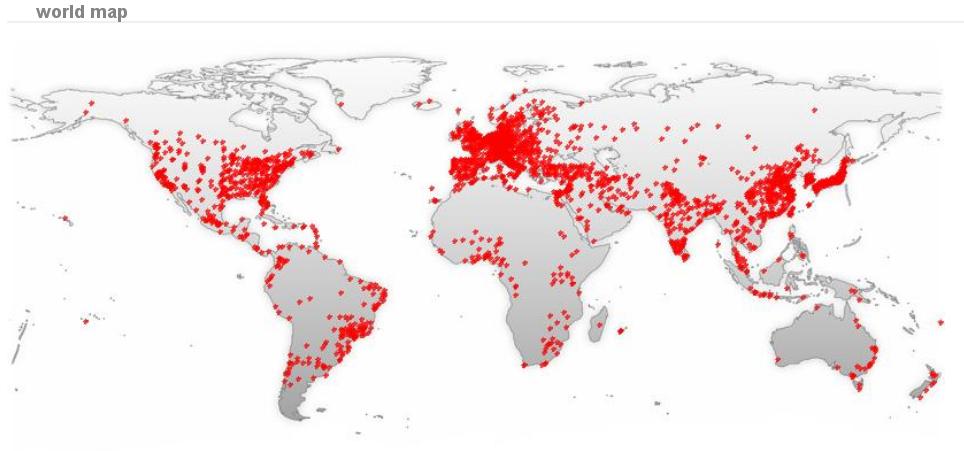博文
2018年全球癌症预测结果
 精选
精选
|||
2018全球癌症预测结果
诸平
2018年全球癌症统计:GLOBOCAN对全球185个国家的36种癌症的发病率和死亡率进行了估计,现将其结果图解如下,仅供参考。
1. 癌症死亡世界分布图
2016年世界卫生组织(WHO)提供的2015年全球70岁以下因癌症死亡人数分布图(图1)。深蓝色是因癌症死亡人数最少的国家或地区,其中包括48个国家;浅蓝色是死亡人数排名第二的43个国家,,排名第三和第四的22个国家用橙色表示,红色是表示因癌症死亡人数排名第五到第十的59个国家;但是,也有些国家或者地区没有相关数据,分别用深银灰色或者浅银灰色表示。

2. 2018年癌症发展趋势
国际癌症研究机构(The International Agency for Research on Cancer,IARC) 2018年9月12日在瑞士日内瓦分布了全球癌症估计的最新结果,GLOBOCAN 2018数据库(The GLOBOCAN 2018 database)可以在线进行检索,它是IARC全球癌症瞭望(IARC Global Cancer Observatory)的一部分,提供了185个国家的36种癌症的发生率(incidence)和死亡率(mortality),相关结果2018年9月12日已经在癌症研究的专业期刊——CA: A Cancer Journal for Clinicians发表。
表1 2016-2018年癌症预测结果
2018 | 全球新增癌症病例1700万(UK);(WHO,2018-09-12, 1810万) | 因癌死亡人数960万(UK, WHO的报道相同) | 与烟草有关的癌症病例约占33% |
美国新增癌症病例1,735,350 | 因癌死亡人数609,640 | ||
2017 | 美国新增癌症病例1,688,780 | 因癌死亡人数600,920 | |
2016 | 美国新增癌症病例1,685,210 | 因癌死亡人数595,690 | |
全球男性一生5人当中就有一人会患癌症;女性是6人中会有一人患癌;因癌死亡人数男性是每死亡8个人中就有一人是与癌症有关;而女性是每死亡11个人中就有一人是与癌症有关。
3. 2018年主要癌症
发病率前3种分别是肺癌、女性乳腺癌以及结肠直肠癌,而这3种癌症按照死亡率排序,在前5名中分别排名第一、第五和第二。在全球范围内,此3种癌症的发病率和死亡率约占世界总数的1/3左右。
4. 美国癌症统计结果
癌症并非仅限于某些国家或者地区,各地癌症的发病率有所差异,但是它其全世界都有,而且随着环境污染(如水污染、空气污染、土壤污染、食物污染、室内污染等)的加重,发病率有越来越高的发展势头。以2017年美国的癌症预测结果为例(见表2),就可以说明这一点(见表1和表2)。
表2 2017年美国癌症预测结果
分类 | 估计新增人数 | 估计死亡人数 | ||||
男女 | 男 | 女 | 男女 | 男 | 女 | |
总数 | 1,688,780 | 836,150 | 852,630 | 600,920 | 318,420 | 282,500 |
消化系统癌 | 310,440 | 175,650 | 134,790 | 157,700 | 92,350 | 65,350 |
食道癌 | 16,940 | 13,360 | 3,580 | 15,690 | 12,720 | 2,970 |
胃癌 | 28,000 | 17,750 | 10,250 | 10,960 | 6,720 | 4,240 |
小肠癌 | 10,190 | 5,380 | 4,810 | 1,390 | 770 | 620 |
结肠癌 | 95,520 | 47,700 | 47,820 | 50,260 | 27,150 | 23,110 |
直肠癌 | 39,910 | 23,720 | 16,190 | |||
肛门癌 | 8,200 | 2,950 | 5,250 | 1,100 | 450 | 650 |
肝癌 | 40,710 | 29,200 | 11,510 | 28,920 | 19,610 | 9,310 |
胆癌 | 11,740 | 5,320 | 6,420 | 3,830 | 1,630 | 2,200 |
胰腺癌 | 53,670 | 27,970 | 25,700 | 43,090 | 22,300 | 20,790 |
其它消化器官癌 | 5,560 | 2,300 | 3,260 | 2,460 | 1,000 | 1,460 |
生殖系统癌 | 279,800 | 172,330 | 107,470 | 59,100 | 27,500 | 31,600 |
乳腺癌 | 255,180 | 2,470 | 252,710 | 41,070 | 460 | 40,610 |
呼吸系统癌 | 243,170 | 133,050 | 110,120 | 160,420 | 88,100 | 72,320 |
泌尿系统癌 | 146,650 | 103,480 | 43,170 | 32,190 | 22,260 | 9,930 |
口腔与咽部癌 | 49,670 | 35,720 | 13,950 | 9,700 | 7,000 | 2,700 |
5. 2018年癌症研究文献分布(Neoplasms[mesh] 2018[time])

6. 前几国的研究成果统计
美国第一、中国第二。

7. 前几座城市的研究结果统计
上海第一、北京第二、广州第六、南京第九。

更多信息请注意浏览相关文献报道。
Global cancer statistics 2018: GLOBOCAN estimates of incidence and mortality worldwide for 36 cancers in 185 countries
Freddie Bray BSc, MSc, PhD;Jacques Ferlay ME ;Isabelle Soerjomataram MD, MSc, PhD ;Rebecca L. Siegel MPH;
Lindsey A. Torre MSPH ;Ahmedin Jemal PhD, DVM
First published: 12 September 2018; https://doi.org/10.3322/caac.21492
Abstract
This article provides a status report on the global burden of cancer worldwide using the GLOBOCAN 2018 estimates of cancer incidence and mortality produced by the International Agency for Research on Cancer, with a focus on geographic variability across 20 world regions. There will be an estimated 18.1 million new cancer cases (17.0 million excluding nonmelanoma skin cancer) and 9.6 million cancer deaths (9.5 million excluding nonmelanoma skin cancer) in 2018. In both sexes combined, lung cancer is the most commonly diagnosed cancer (11.6% of the total cases) and the leading cause of cancer death (18.4% of the total cancer deaths), closely followed by female breast cancer (11.6%), prostate cancer (7.1%), and colorectal cancer (6.1%) for incidence and colorectal cancer (9.2%), stomach cancer (8.2%), and liver cancer (8.2%) for mortality. Lung cancer is the most frequent cancer and the leading cause of cancer death among males, followed by prostate and colorectal cancer (for incidence) and liver and stomach cancer (for mortality). Among females, breast cancer is the most commonly diagnosed cancer and the leading cause of cancer death, followed by colorectal and lung cancer (for incidence), and vice versa (for mortality); cervical cancer ranks fourth for both incidence and mortality. The most frequently diagnosed cancer and the leading cause of cancer death, however, substantially vary across countries and within each country depending on the degree of economic development and associated social and life style factors. It is noteworthy that high‐quality cancer registry data, the basis for planning and implementing evidence-based cancer control programs, are not available in most low‐ and middle‐income countries. The Global Initiative for Cancer Registry Development is an international partnership that supports better estimation, as well as the collection and use of local data, to prioritize and evaluate national cancer control efforts. CA: A Cancer Journal for Clinicians 2018;0:1‐31.
https://blog.sciencenet.cn/blog-212210-1148835.html
上一篇:晶体电子显微镜技术开发者逝世
下一篇:2018年有关癌症消息的补充